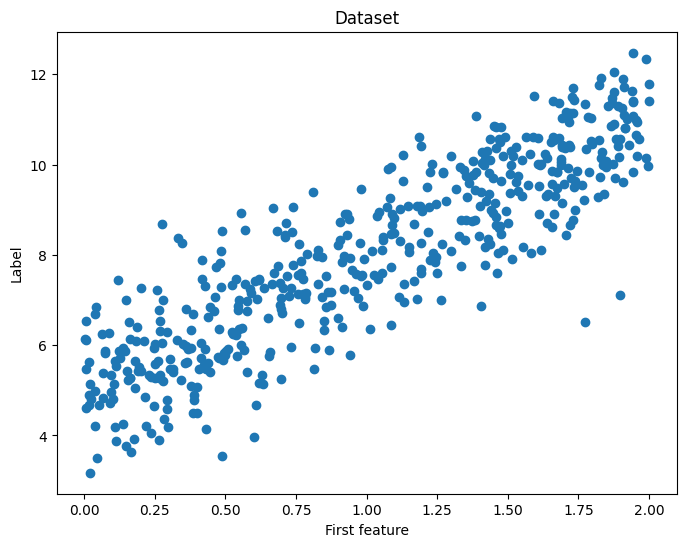Linear Regression with SKLearn#
References:
import matplotlib.pyplot as plt
import numpy as np
from sklearn.linear_model import LinearRegression
from sklearn.metrics import mean_squared_error, r2_score
from sklearn.model_selection import train_test_split
np.random.seed(123)
Dataset#
# We will use a simple training set
X = 2 * np.random.rand(500, 1)
y = 5 + 3 * X + np.random.randn(500, 1)
fig = plt.figure(figsize=(8, 6))
plt.scatter(X, y)
plt.title("Dataset")
plt.xlabel("First feature")
plt.ylabel("Label")
plt.show()

# Split the data into a training and test set
X_train, X_test, y_train, y_test = train_test_split(X, y)
print(f"Shape X_train: {X_train.shape}")
print(f"Shape y_train: {y_train.shape}")
print(f"Shape X_test: {X_test.shape}")
print(f"Shape y_test: {y_test.shape}")
Shape X_train: (375, 1)
Shape y_train: (375, 1)
Shape X_test: (125, 1)
Shape y_test: (125, 1)
Training#
regr = LinearRegression()
regr.fit(X_train, y_train)
LinearRegression()In a Jupyter environment, please rerun this cell to show the HTML representation or trust the notebook.
On GitHub, the HTML representation is unable to render, please try loading this page with nbviewer.org.
LinearRegression()
Testing#
y_pred = regr.predict(X_test)
y_pred[:10]
array([[10.23509009],
[ 7.96013802],
[ 8.24265637],
[ 5.71975515],
[ 4.91785424],
[ 5.64173755],
[10.77645888],
[ 6.28942254],
[10.91860508],
[ 6.24259349]])
y_test[:10]
array([[11.43392748],
[ 7.33861245],
[ 8.9137441 ],
[ 8.67468833],
[ 5.63189611],
[ 6.01422288],
[11.71427334],
[ 6.74555903],
[10.18985201],
[ 6.83689782]])
# The mean squared error
print("Mean squared error: %.2f" % mean_squared_error(y_test, y_pred))
Mean squared error: 0.87
Visualize prediction output#
plt.scatter(X_test, y_test, color="black")
plt.plot(X_test, y_pred, color="blue", linewidth=3)
plt.xticks(())
plt.yticks(())
plt.show()


